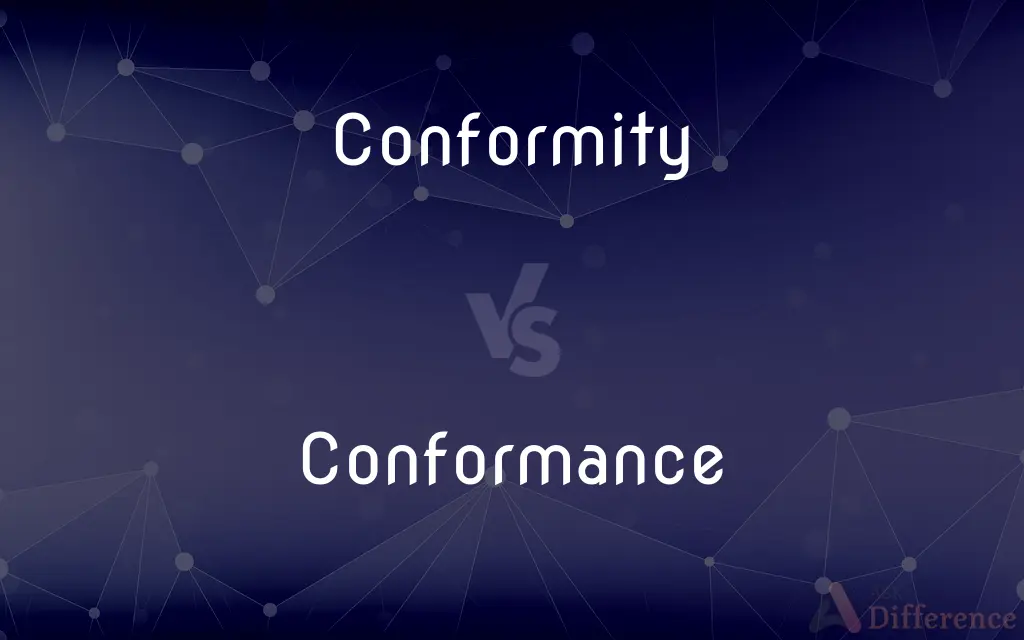Conformity vs. Conformance — What's the Difference?
Edited by Tayyaba Rehman — By Urooj Arif — Updated on March 24, 2024
Conformity refers to behavioral alignment with social norms or group standards, while conformance is adherence to technical or specific standards.

Difference Between Conformity and Conformance
Table of Contents
ADVERTISEMENT
Key Differences
Conformity involves adjusting one's behavior or beliefs to match those of a group or societal expectations, often driven by the desire for social acceptance or the perceived pressure to fit in. This can include a wide range of behaviors, from following fashion trends to adopting group attitudes. Conformance, on the other hand, pertains to meeting defined specifications, rules, or standards, typically in a technical, business, or regulatory context. It is about ensuring that products, services, or processes align with established guidelines or criteria.
The motivation behind conformity is primarily psychological, rooted in the human need for social belonging and acceptance. People may conform to avoid conflict or to gain approval from peers. Conformance is motivated by external requirements or objectives, such as meeting quality standards, regulatory compliance, or achieving certification. The focus is on objective criteria rather than social acceptance.
Conformity is often studied in social psychology as it pertains to human behavior and social interactions. It is associated with social influences, peer pressure, and cultural norms. Conformance is more relevant in fields like engineering, quality control, and regulatory compliance, where precise adherence to technical standards is critical.
The consequences of not adhering to conformity can include social ostracism, peer rejection, or personal conflict, affecting an individual's social standing or internal sense of belonging. In contrast, failing to achieve conformance can result in practical repercussions such as product recalls, legal penalties, or loss of certification, impacting operational efficiency and market reputation.
While conformity can be seen as a dynamic and sometimes subjective process influenced by changing social norms and cultural trends, conformance is typically more static, defined by specific and measurable criteria set by authoritative bodies or industry standards. This distinction highlights the fluid nature of social behavior versus the structured approach to quality and regulatory compliance.
ADVERTISEMENT
Comparison Chart
Definition
Adjusting behavior to align with social norms
Adhering to technical or specific standards
Motivation
Social acceptance, peer pressure
Compliance with external requirements
Relevant Fields
Social psychology, sociology
Engineering, quality control, regulatory compliance
Consequences of Non-adherence
Social ostracism, personal conflict
Legal penalties, loss of certification
Nature
Subjective and dynamic
Objective and static
Compare with Definitions
Conformity
The act of aligning one's behavior or beliefs with group norms.
Conformity in fashion trends often dictates the popularity of certain styles.
Conformance
The act of meeting established specifications or standards.
Conformance to safety standards is crucial in product manufacturing.
Conformity
Heavily influenced by group dynamics and peer pressure.
Teenagers exhibit conformity when they adopt the habits of their friend groups.
Conformance
Essential for legal and operational approval.
Conformance to environmental regulations is mandatory for many businesses.
Conformity
Can change over time with societal norms.
Conformity to social norms evolves as cultural attitudes shift.
Conformance
Legal or operational penalties for non-conformance.
Failure in product conformance can lead to recalls and legal issues.
Conformity
Rooted in the need for acceptance and belonging.
Conformity in opinions often stems from a fear of being marginalized.
Conformance
Involves precise adherence to guidelines.
Software conformance to industry standards ensures compatibility.
Conformity
Social ostracism or internal conflict for non-conformity.
Lack of conformity in social settings can lead to isolation.
Conformance
Requires consistent application of standards.
Conformance in production processes ensures quality control.
Conformity
Conformity is the act of matching attitudes, beliefs, and behaviors to group norms, politics or being like-minded. Norms are implicit, specific rules, shared by a group of individuals, that guide their interactions with others.
Conformance
Conformity.
Conformity
Similarity in form or character; agreement
I acted in conformity with my principles.
Conformance
The act of conforming; conformity.
Conformity
Action or behavior in correspondence with socially accepted standards, conventions, rules, or laws
Conformity to university regulations.
Conformance
Conformity.
Conformity
The relationship between rock or sediment strata that were deposited adjacently or vertically in sequence without any interruption due to erosion, tilting, folding, or similar natural processes.
Conformance
Correspondence in form or appearance
Conformity
A surface exhibiting such a relationship between older rock strata and younger rock strata.
Conformity
The state of things being similar or identical.
Conformity
A point of resemblance; a similarity.
Conformity
The state of being conforming, of complying with a set of rules, with a norm or standard.
Conformity
The ideology of adhering to one standard or social uniformity.
Conformity
Correspondence in form, manner, or character; resemblance; agreement; congruity; - followed by to, with, or between.
By our conformity to God.
The end of all religion is but to draw us to a conformity with God.
A conformity between the mental taste and the sensitive taste.
Conformity
Compliance with the usages of the Established Church.
The king [James I.] soon afterward put forth a proclamation requiring all ecclesiastical and civil officers to do their duty by enforcing conformity.
Conformity
Correspondence in form or appearance
Conformity
Acting according to certain accepted standards
Conformity
Orthodoxy in thoughts and belief
Conformity
Concurrence of opinion;
We are in accord with your proposal
Conformity
Hardened conventionality
Common Curiosities
Can an individual display both conformity and conformance?
Yes, individuals can exhibit conformity in social contexts and conformance in professional or technical settings.
Can conformity lead to negative outcomes?
Yes, excessive conformity can suppress individuality and lead to negative outcomes like groupthink or loss of personal identity.
How do social norms influence conformity?
Social norms are the unwritten rules of behavior in a society or group, heavily influencing individuals to conform to gain acceptance.
Are there cultural differences in conformity?
Yes, the degree and nature of conformity can vary significantly across different cultures based on societal norms and values.
Is conformity always voluntary?
Conformity can be both voluntary and involuntary, often influenced by the desire for social acceptance or the pressure to fit in.
Why is conformance important in manufacturing?
Conformance ensures that products meet safety, quality, and performance standards, which is vital for consumer trust and regulatory compliance.
How do organizations ensure conformance to standards?
Organizations use quality management systems, audits, and certifications to ensure conformance to industry and regulatory standards.
How does peer pressure relate to conformity?
Peer pressure is a key factor in conformity, as individuals often change their behavior or beliefs to align with their peer group's expectations.
How is conformance measured?
Conformance is measured against specific criteria or standards through testing, inspection, and certification processes.
Can conformance limit innovation?
While conformance ensures safety and reliability, overly rigid adherence to standards can sometimes stifle creativity and innovation.
What role do regulatory bodies play in conformance?
Regulatory bodies set standards and guidelines to ensure safety, quality, and fairness, overseeing compliance through inspections and audits.
Can digital platforms influence conformity?
Yes, digital platforms, especially social media, can amplify conformity by showcasing and rewarding certain behaviors or trends.
How do personal values affect conformity?
Individuals with strong personal values may resist conformity when it conflicts with their beliefs, demonstrating integrity and independence.
Is conformance always beneficial for a business?
While conformance is critical for quality and safety, businesses must also balance it with flexibility and innovation to remain competitive.
How do societal changes impact conformity?
Societal changes, such as shifts in cultural attitudes or technological advancements, can redefine what is considered normative behavior, influencing levels of conformity.
Share Your Discovery

Previous Comparison
Landing vs. Touchdown
Next Comparison
Expanse vs. ExpansionAuthor Spotlight
Written by
Urooj ArifUrooj is a skilled content writer at Ask Difference, known for her exceptional ability to simplify complex topics into engaging and informative content. With a passion for research and a flair for clear, concise writing, she consistently delivers articles that resonate with our diverse audience.
Edited by
Tayyaba RehmanTayyaba Rehman is a distinguished writer, currently serving as a primary contributor to askdifference.com. As a researcher in semantics and etymology, Tayyaba's passion for the complexity of languages and their distinctions has found a perfect home on the platform. Tayyaba delves into the intricacies of language, distinguishing between commonly confused words and phrases, thereby providing clarity for readers worldwide.














































